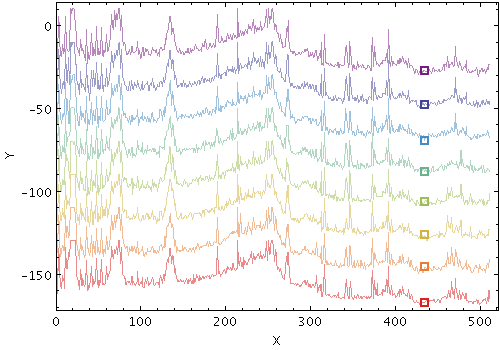
handles
Draws a symbol representing the position of an X/Y array plot. Although this may not do a good job of showing the position for a whole X/Y array, which is line-like rather than point-like, it provides a visible reference position for the plotted row.
This plot type is therefore mostly useful in interactive environments like TOPCAT, where the plotted marker can be used for activating or identifying the corresponding table row.
Usage Overview:
layerN=handles placementN=index|ymax|ymin|xmax|xmin|xymean fractionN=<0..1>
sizeN=<pixels> shapeN=filled_circle|open_circle|...
shadingN=auto|flat|translucent|transparent|density|aux|weighted|paux|pweighted <shade-paramsN>
xsN=<array-expr> ysN=<array-expr> inN=<table>
ifmtN=<in-format> istreamN=true|false icmdN=<cmds>
All the parameters listed here
affect only the relevant layer,
identified by the suffix
N.
Example:

stilts plot2plane in=LRS_NPW_V010_20071101.cdf ys=add(RX1,20*$index)
shading=aux auxmap=sron aux=$index
icmd='head 8' auxvisible=false legend=false
layer0=lines opaque0=2
layer1=handles placement1=index fraction1=0.85
fractionN = <0..1> (Double)
placement=index,
where it indicates how far through the array
the reference (X,Y) position should be taken
(0.0 means the first element, 1.0 means the last).
For other values of
placement
it is ignored.
[Default: 0.5]
icmdN = <cmds> (ProcessingStep[])
inN.
The value of this parameter is one or more of the filter
commands described in Section 6.1.
If more than one is given, they must be separated by
semicolon characters (";").
This parameter can be repeated multiple times on the same
command line to build up a list of processing steps.
The sequence of commands given in this way
defines the processing pipeline which is performed on the table.
Commands may alternatively be supplied in an external file,
by using the indirection character '@'.
Thus a value of "@filename"
causes the file filename to be read for a list
of filter commands to execute. The commands in the file
may be separated by newline characters and/or semicolons,
and lines which are blank or which start with a
'#' character are ignored.
A backslash character '\' at the end of a line
joins it with the following line.
ifmtN = <in-format> (String)
inN.
The known formats are listed in Section 5.1.1.
This flag can be used if you know what format your
table is in.
If it has the special value
(auto) (the default),
then an attempt will be
made to detect the format of the table automatically.
This cannot always be done correctly however, in which case
the program will exit with an error explaining which
formats were attempted.
This parameter is ignored for scheme-specified tables.
[Default: (auto)]
inN = <table> (StarTable)
-",
meaning standard input.
In this case the input format must be given explicitly
using the ifmtN
parameter.
Note that not all formats can be streamed in this way.:<scheme-name>:<scheme-args>.<" character at the start,
or a "|" character at the end
("<syscmd" or
"syscmd|").
This executes the given pipeline and reads from its
standard output.
This will probably only work on unix-like systems.istreamN = true|false (Boolean)
inN parameter
will be read as a stream.
It is necessary to give the
ifmtN parameter
in this case.
Depending on the required operations and processing mode,
this may cause the read to fail (sometimes it is necessary
to read the table more than once).
It is not normally necessary to set this flag;
in most cases the data will be streamed automatically
if that is the best thing to do.
However it can sometimes result in less resource usage when
processing large files in certain formats (such as VOTable).
This parameter is ignored for scheme-specified tables.
[Default: false]
placementN = index|ymax|ymin|xmax|xmin|xymean (XYArrayPlacement)
The available options are:
index: (X,Y) point at a certain fraction of the way through the arrays, as given by the fraction value; fraction=0.0 is the first element, fraction=1.0 is the last.ymax: (X,Y) position at which the maximum Y value is located (fraction is ignored)ymin: (X,Y) position at which the minimum Y value is located (fraction is ignored)xmax: (X,Y) position at which the maximum X value is located (fraction is ignored)xmin: (X,Y) position at which the minimum X value is located (fraction is ignored)xymean: center of gravity of all the (X,Y) points (fraction is ignored)[Default: index]
shadingN = auto|flat|translucent|transparent|density|aux|weighted|paux|pweighted <shade-paramsN> (ShapeMode)
[Default: auto]
shapeN = filled_circle|open_circle|... (MarkerShape)
The available options are:
filled_circle
open_circle
cross
x
open_square
open_diamond
open_triangle_up
open_triangle_down
fat_circle
fat_cross
fat_x
fat_square
fat_diamond
fat_triangle_up
fat_triangle_down
filled_square
filled_diamond
filled_triangle_up
filled_triangle_down
[Default: fat_square]
sizeN = <pixels> (Integer)
[Default: 4]
xsN = <array-expr> (String)
The value is an array-valued algebraic expression based on column names as described in Section 10. Some of the functions in the Arrays class may be useful here.
ysN = <array-expr> (String)
The value is an array-valued algebraic expression based on column names as described in Section 10. Some of the functions in the Arrays class may be useful here.